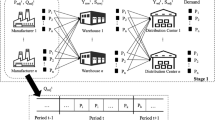Abstract
The main purpose of Master Planning is to synchronize the flow of materials along the entire supply chain. Master Planning supports mid-term decisions on efficient utilization of production, transport, supply capacities, seasonal stock as well as balancing of supply and demand. As a result of this synchronization, production and distribution entities are able to reduce their inventory levels. Without centralized Master Planning, larger buffers are required in order to ensure a continuous flow of material. Coordinated master plans provide the ability to reduce these safety buffers by decreasing the variance of production and distribution quantities.
Access this chapter
Tax calculation will be finalised at checkout
Purchases are for personal use only
Preview
Unable to display preview. Download preview PDF.
Similar content being viewed by others
References
Bitran, G. R.; Haas, E. A.; Hax, A. C. (1982) Hierarchical production planning: A two-stage system, in: Operations Research, Vol. 30, 232–251
Schneeweiss, C. (1999) Hierarchies in distributed decision making,Berlin et al.
Shapiro, J. F. (1999) Bottom-up vs. top-down approaches to supply chain modeling, in: Tayur, S.; Ganeshan, R.; Magazine, M. (Eds.) Quantitative models for supply chain management, Dordrecht, The Netherlands, 737–760
Stadtler, H. (1988) Hierarchische Produktionsplanung bei losweiser Fertigung,Heidelberg
Stadtler, H. (1996) Mixed integer programming model formulations for dynamic multi-item multi-level capacitated lotsizing, in: European Journal of Operational Research, Vol. 94, 561–581
Stadtler, H. (1998) Hauptproduktionsprogrammplanung in einem kapazitätsorientierten PPS-System,in: Wildemann, H. (Ed.) Innovationen in der Produktionswirtschaft - Produkte, Prozesse, Planung und Steuerung,München, 163–192
Tempelmeier, H. (1999) Material-Logistik: Modelle und Algorithmen für die Produktionsplanung und -steuerung und das Supply Chain Management,4th ed., Berlin et al.
Author information
Authors and Affiliations
Editor information
Editors and Affiliations
Rights and permissions
Copyright information
© 2002 Springer-Verlag Berlin Heidelberg
About this chapter
Cite this chapter
Rohde, J., Wagner, M. (2002). Master Planning. In: Stadtler, H., Kilger, C. (eds) Supply Chain Management and Advanced Planning. Springer, Berlin, Heidelberg. https://doi.org/10.1007/978-3-662-10142-1_9
Download citation
DOI: https://doi.org/10.1007/978-3-662-10142-1_9
Publisher Name: Springer, Berlin, Heidelberg
Print ISBN: 978-3-662-10144-5
Online ISBN: 978-3-662-10142-1
eBook Packages: Springer Book Archive




